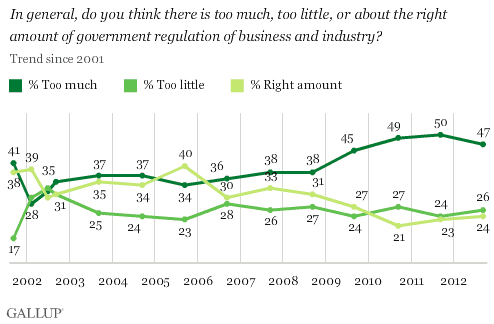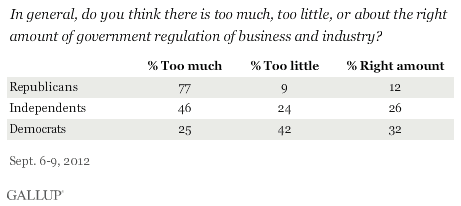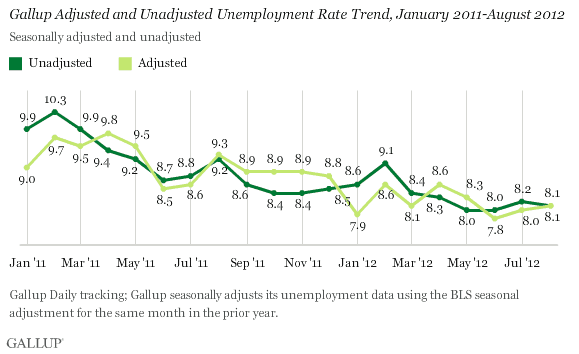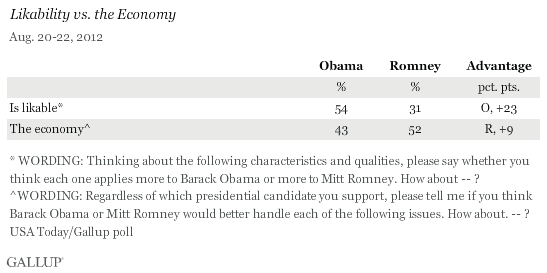-
The USA Today / Gallup Poll Has Romney Leading Obama by 4 Points
According to the latest USA Today / Gallup Presidential Poll.
Mitt Romney leads President Obama by four percentage points among likely voters in the nation’s top battlegrounds, a USA TODAY/Gallup Poll finds, and he has growing enthusiasm among women to thank.
As the presidential campaign heads into its final weeks, the survey of voters in 12 crucial swing states finds female voters much more engaged in the election and increasingly concerned about the deficit and debt issues that favor Romney. The Republican nominee now ties the president among women who are likely voters, 48%-48%, while he leads by 12 points among men.
The battle for women, which was apparent in the speakers spotlighted at both political conventions this summer, is likely to help define messages the candidates deliver at the presidential debate Tuesday night and in the TV ads they air during the final 21 days of the campaign. As a group, women tend to start paying attention to election contests later and remain more open to persuasion by the candidates and their ads.
That makes women, especially blue-collar “waitress moms” whose families have been hard-hit by the nation’s economic woes, the quintessential swing voters in 2012’s close race.
The conventional wisdom is that President Obama will be the aggressor at tomorrow night’s town-hall style Presidential debate. But, there is risk to that approach, especially with women.
In any case, Mitt Romney is in far better shape on the eve of the second Presidential debate than he was before the first.
Stay tuned…..
-
Pre-Debate Poll Watch: Ryan and Biden Both With Lackluster Favorability
According to the latest Gallup Poll:
Americans view Vice President Joe Biden and Republican vice presidential nominee Paul Ryan similarly heading into Thursday’s vice presidential debate, with 44% viewing Biden and 43% viewing Ryan favorably. This contrasts with most other vice presidential pairings since 1992 when one candidate had higher favorable ratings than the other in advance of the election’s vice presidential debate.
At 44%, Biden has the lowest pre-debate favorable rating of any Democratic vice presidential candidate of the past six elections. At 43%, Ryan’s favorable score is no better, but he is viewed more positively than Vice President Quayle was in 1992 and roughly on par with Cheney in 2000. Both of those candidates were associated with Republican tickets that lost the popular vote (although, in the case of Bush/Cheney, not the Electoral College).
Al Gore was easily the most popular vice presidential candidate of the last two decades. More than six in 10 Americans viewed him favorably prior to the 1996 and 1992 vice presidential debates, eclipsing both of his opponents’ favorable scores: Jack Kemp’s 51% and Dan Quayle’s 33%. John Edwards was viewed significantly better than Dick Cheney in 2004. Also, Joe Lieberman in 2000 and Sarah Palin in 2008 had slim favorability advantages over their counterparts.
But, does it really make any difference in the Presidential race?
Probably not and history says not so much.
Unless Ryan or Biden has a complete meltdown on stage, I would think that not too much would change in the polls. But, Biden probably has the bigger downside since President Obama performed so poorly in his first debate against Mitt Romney.
Biden and Ryan will take the stage in Danville, Ky., on Thursday about equally well-liked by Americans. Gallup trends suggest that past vice presidential debates have had little to no impact on voter preferences; nevertheless, the current parity between Biden and Ryan theoretically gives them equal opportunity to use the debate to their team’s advantage, something Biden may be particularly focused on given Obama’s subpar performance in the first presidential debate. However, demonstrating that pre-existing views are not determinative, Obama entered that debate with a 55% to 47% advantage over Romney in favorability, and yet, by 72% to 20%, debate viewers said Romney rather than Obama did the better job.
How much vice presidential popularity matters to the outcome of presidential elections is another question. The ticket with the more popular vice presidential candidate at the end of the campaign won in 1992, 1996, and 2008. However, George W. Bush won re-election in 2004, and roughly tied Al Gore in the popular vote in 2000 despite Cheney’s favorability deficits to Edwards and Lieberman, respectively.
-
Gallup Poll: Romney Post Debate Draws Even with Obama
Matt Drudge is screaming the result on this Monday federal holiday (Columbus Day) morning. Here is the poll chart:
Romney DID win the debate decisively – in historic proportions:

This may be the start of a Romney surge as obviously American voters are becoming more comfortable with Mitt Romney. Will this be a repeat of the 1980 campaign of Reagan Vs. Carter as Reagan surged after the Presidential debates?
And, how will the Paul Ryan vs. Joe Biden debate this Thursday effect the race?
Stay tuned as each campaign adapts to the changing electoral landscape.
-
Poll: Americans Don’t Want MORE Government Regulation of Business and Industry

According to the latest Gallup Poll.
Americans say there is too much (47%) rather than too little (26%) government regulation of business and industry, with 24% saying the amount of regulation is about right. Americans have been most likely to say there is too much regulation of business over the last several years, but prior to 2006, Americans’ views on the issue of government regulation of business were more mixed.
The collapse of Lehman Bros., the failure of the secondary mortgage market, and other business problems in 2008 and 2009 might have been expected to increase Americans’ desire for more government control of business and industry. But that was not the case. Americans’ views that there is too much government regulation in fact began to rise in 2009, perhaps in response to the new Obama administration and new business regulation policies such as Dodd-Frank, reaching an all-time high of 50% in 2011 before settling down slightly this year to 47%.
There has been little change since 2003 in the percentage of Americans saying there is too little regulation of business. The changes that have occurred in recent years have involved shifts between the percentages choosing the “too much” and “about right” alternatives.
Congressional Democrats and President Obama are vulnerable on this issue and this is certainly exploitable by the GOP.
I, certainly, would have expected to see some national cable television ads on this subject. But, maybe, they will be hitting this issue hard in the coming weeks with their ad buys.
Even independent voters say there is too much government regulation of business.
Here is the chart:
What does this mean?
Despite what some observers call a pattern of excess by big business that helped lead to the 2008 recession, Americans continue to say there is too much rather than too little government regulation of business. In fact, over the 15 times since 1993 that Gallup has asked this question, never have more than a third of Americans said there is too little regulation of business and industry.
The increase in the “too much” viewpoint since 2008 largely results from Republicans’ increased agreement with this point — most likely reflecting their reaction to Democratic President Obama’s election and his policies once in office.
All in all, the results suggest that a call from Mitt Romney for a reduction in government regulations and red tape may strike a more responsive chord from the average American, particularly independent Americans, than a call from Obama for more regulation.
-
Gallup: American Unadjusted Unemployment Rate Is 8.1 %
According to the latest Gallup Poll:
U.S. unemployment, as measured by Gallup without seasonal adjustment, is 8.1% for the month of August, down slightly from 8.3% measured in mid-August and 8.2% for the month of July. Gallup’s seasonally adjusted unemployment rate for August is also 8.1%, a slight uptick from 8.0% at the end of July.
These results are based on Gallup Daily tracking interviews, conducted by landline and cell phone, with more than 30,000 Americans throughout the month. Gallup calculates a seasonally adjusted unemployment rate by applying the adjustment factor the government used for the same month in the previous year. The government adjusted its July numbers downward last year, but made no adjustment in August, which accounts for the increase in seasonally adjusted unemployment despite the decline in the unadjusted number.
U.S. unemployment declined significantly during the first part of the year, but August marks the third straight month with little change in the unadjusted number. Gallup’s estimate of adjusted unemployment has increased by 0.3 percentage points since June. Despite the lackluster jobs growth, August’s 2012 unadjusted and adjusted unemployment are each more than a full point lower than they were in August 2011.
Underemployment is also down a bit.
Underemployment, as measured without seasonal adjustment, was 17.1% in August, unchanged from the end of July but significantly improved from 18.5% a year ago. Gallup’s U.S. underemployment measure combines the percentage who are unemployed with the percentage of those working part time but looking for full-time work. Gallup does not apply a seasonal adjustment to underemployment.
The pundits anxiously await the BOL official jobs numbers on Friday. If the numbers show a declining unemployment rate, then President Obama may have a bigger bounce in his re-election poll numbers.
However, with the Obama re-election folks trying to loser expectations on the eve of the President’s acceptance speech tonight, I suspect these numbers will be slightly improved or unchanged.
The decline in unemployment seen earlier in the year has not been sustained, with unadjusted unemployment flat over the past three months. Although there is no longer a net loss of jobs, employers are not adding enough jobs to dramatically reduce the unemployment rate.
Gallup’s slight increase in seasonally adjusted unemployment indicates that the unemployment rate the Bureau of Labor Statistics releases on Friday will likely remain flat and possibly increase by a tenth of a point.
Unemployment hovering just above 8.0% could have important implications for President Barack Obama as the election nears. The only incumbent president since 1912 to win his re-election bid when the unemployment rate exceeded 8.0% was Franklin Roosevelt, who was re-elected as the U.S. recovered from the Great Depression. What may matter more, though, is the direction of the unemployment rate, which provides mixed signals for Obama’s chances — improving earlier this year but leveling off in recent months.
-
What One Word Describes Joe Biden? How About Idiot
Vice President Joe Biden
The Pew Research Center has the polling.
Asked for their one-word impression of Joe Biden, more people use negative than positive words to describe the vice president. Many of the negative words disparage Biden’s competence and performance, with idiot, incompetent and clown among the terms used most frequently.
Of those offering a word to describe Biden, 38% use negative terms, while 23% give positive words. About four-in-ten (39%) use neutral terms, with vice president among the most common, according to the latest national survey of 1,008 adults by the Pew Research Center and the Washington Post, conducted Aug. 31-Sept. 3, 2012.
You know, I am really surprised that with President Obama in a tight re-election race that he would have not “retired” good ol’ gaffe prone Joe and swapped in someone who could help the party, like Hillary Clinton.
Oh well, Obama is stuck with Biden now.
Paul Ryan will have Joe for lunch during the Vice Presidential debate.
-
Poll: Obama More Likable But Romney is About the Economy
According to the latest Gallup Poll:
As the two-week period of back-to-back presidential nominating conventions gets underway next Monday, an Aug. 20-22 USA Today/Gallup poll underscores the strengths and weaknesses of each of the two candidates at this point in the campaign. Barack Obama retains a significant edge over Mitt Romney on personal dimensions, particularly in terms of his “likability,” while Americans still believe Romney is better able to handle the economy.
This Presidential race is all about the economy.
Likability does not put food on the table or a car in the garage.
Americans can like their President, but if he is not producing results – he is OUT.
-
Poll: Men Prefer Romney – Women Prefer Obama
According to the latest Gallup Poll:
Male voters currently prefer Mitt Romney over Barack Obama by an eight-percentage-point margin, while female voters prefer Obama over Romney by an identical eight points. These gender-gap figures, based on Gallup Daily tracking conducted July 30-Aug. 19, are virtually identical to what they were four months ago.
The impact of gender on the presidential race has received a renewed focus in recent days after Missouri Republican senatorial candidate Todd Akin’s controversial comments about rape and abortion. It’s too early to tell if this incident and the resulting fallout will have a long-term impact on the presidential gender gap, but from a broad perspective, Gallup’s large sample sizes show a remarkable stability by gender since tracking began in mid-April.
The gender gap is driven mostly by the underlying differences in party identification. Women are more likely to identify as Democrats and less likely to identify as independents than are men. Within party groups, gender gaps are quite small.
This is not really a surprise since a gender gap has been known to exist for some time.
But, will the Todd Akin flap about legitimate rape flip a few more women to the Democrats. It remains to be seen and Akin could still quit the race – and the GOP will do what it can to force him out.
The gender gap in presidential preferences has not changed over the last four months, with men preferring Romney over Obama by eight points, while women prefer Obama by an identical margin.
The nature of the gender gap varies significantly across demographic segments. Support for Obama is so strong among black voters that gender makes little difference, but both white and Hispanic women are more likely to support Obama than are men in each of these groups. Women are more strongly for Obama than are men across all age groups, and the gender gap is starkly evident among voters with postgraduate education.
All in all, women, those under 30, those with postgraduate education, and those who are black and Hispanic give Obama his strongest support. Conversely, Romney receives his strongest support among men who have college degrees but no postgraduate education, and among older and white men.
-
Gallup Poll Watch: U.S. Economic Confidence Looks Bleak
According to the latest Gallup Poll.
Americans continue to have both a negative view of current U.S. economic conditions and a bleak outlook for the U.S. economy’s future, resulting in a Gallup Economic Confidence Index reading of -28 for the week of Aug. 13-19 — basically unchanged from the previous week.
Americans’ economic confidence has been low for most of the summer so far, with weekly averages between -23 and -29 since June 11. Prior to that, Americans had been somewhat more optimistic, and the weekly average of -16 in late May represented the highest confidence reading of the year. The -29 reached in January and again in late July represent the low points of the year so far. At the same time, Americans’ confidence was significantly lower in the latter part of 2011 than it is now.
Gallup’s Economic Confidence Index consists of two measures — one assessing current economic conditions and the other assessing the nation’s economic outlook.
I don’t see any burst of economic confidence out here in California. In fact, the news is filled with noise of impending business troubles and municipal bankruptcies.
So, what does this mean?
President Obama and other incumbent POLS don’t have much positive economic momentum to run for re-election.
-
President 2012 Poll Watch: Paul Ryan a Mixed Reaction?

Paul Ryan and Mitt Romney
According to the latest Gallup/USA Today poll.
Americans don’t believe GOP presidential contender Mitt Romney hit a home run with his choice of Paul Ryan as a running mate, a USA TODAY/Gallup Poll finds, with more of the public giving him lower marks than high ones.
Ryan, a Wisconsin congressman, is seen as only a “fair” or “poor” choice by 42% of Americans vs. 39% who think he is an “excellent” or “pretty good” vice presidential choice.
I would wait a few weeks and after the national conventions before a “REAL” assessment can be made of Paul Ryan’s impact on the Republican Party ticket. Besides, it is the last few weeks of summer and who is answering the pollsters calls on a weekend?
Most Americans don’t really recognize Ryan as a national political figure. His name recognition at this point in the campaign is just not that high.
But, it is interesting that President Obama took time, the first thing this morning in Iowa, to attack Ryan. Guess Team Obama is not reading too much into this early poll.
Neither should we….









